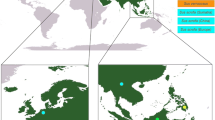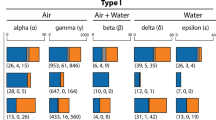Abstract
Background
Cervids have evolved very successful means for survival and thriving to adapt to various climates and environments. One of these successful means might be the effective and efficient way of communication. To support this notion, cervids are well equipped with a variety of skin glands that distribute in different body regions. However, studies relevant to adaptive evolution in cervids, particularly on olfactory reception at the molecular level, have thus far not been reported.
Objective
To provide valuable insights into molecular evidence for the adaptive evolution of olfactory-related gene in cervids.
Methods
Based on recently sequenced genomes of cervids and closely-related-species, we performed comparative genomic analysis at genome level using bioinformatics tools.
Results
Tree topology strongly supported that Bovidae was the sister group of Moschidae and both formed a branch that was then clustered with Cervidae. Expansion of heavy chain genes of the dynein family and 51 rapidly evolving genes could be associated with adaptation of cilia that serve as sensory organelles and act as cellular antennae. Based on the branch-site model test along the deer branch spanning 7–21 mammalian species, 14 deer olfactory receptor genes were found to be undergoing positive selection pressure and 89 positive selection sites (probability > 60%) had amino acid substitutions unique to deer.
Conclusion
This study, for the first time, provides significant molecular evidence for adaption of olfactory-related genes of cervids according to their olfactory behavior.


Similar content being viewed by others
References
Adams MG, Johnson E (2010) Seasonal changes in the skin glands of Roe deer (Capreolus capreolus). Proc Zool Soc Lond 191:509–520
Adams M, Smith UM, Logan CV, Johnson CA (2008) Recent advances in the molecular pathology, cell biology and genetics of ciliopathies. J Med Genet 45:257–267
Bana NA, Nyiri A, Nagy J, Frank K, Nagy T, Steger V, Schiller M, Lakatos P, Sugar L, Horn P et al (2018) The red deer Cervus elaphus genome CerEla1.0: sequencing, annotating, genes, and chromosomes. Mol Genet Genomics 293:665–684
Chen L, Qiu Q, Jiang Y, Wang K, Lin Z, Li Z, Bibi F, Yang Y, Wang J, Nie W et al (2019) Large-scale ruminant genome sequencing provides insights into their evolution and distinct traits. Science. https://doi.org/10.1126/science.aav6202
Edgar RC (2004) MUSCLE: multiple sequence alignment with high accuracy and high throughput. Nucleic Acids Res 32:1792–1797
Fan Z, Li W, Jin J, Cui K, Yan C, Peng C, Jian Z, Bu P, Price M, Zhang X et al (2018) The draft genome sequence of forest musk deer (Moschus berezovskii). Gigascience. https://doi.org/10.1093/gigascience/giy038
Groves C (2007) Family cervidae. In: Prothero DR, Foss SE (eds) The evolution of artiodactyls. Johns Hopkins University Press, Baltimore
Grubb P (1993) Mammal species of the world. In: Wilson DE, Reeder DM (eds) A taxonomic geographic reference. Johns Hopkins University Press, Baltimore, pp 384–392
Han MV, Thomas GW, Lugo-Martinez J, Hahn MW (2013) Estimating gene gain and loss rates in the presence of error in genome assembly and annotation using CAFE 3. Mol Biol Evol 30:1987–1997
He Z, Zhang H, Gao S, Lercher MJ, Chen WH, Hu S (2016) Evolview v2: an online visualization and management tool for customized and annotated phylogenetic trees. Nucleic Acids Res 44:W236–W241
Hedges SB, Marin J, Suleski M, Paymer M, Kumar S (2015) Tree of life reveals clock-like speciation and diversification. Mol Biol Evol 32:835–845
Huang DW, Sherman BT, Lempicki RA (2009) Systematic and integrative analysis of large gene lists using DAVID bioinformatics resources. Nat Protoc 4:44–57
King SM (2010) Sensing the mechanical state of the axoneme and integration of Ca2+ signaling by outer arm dynein. Cytoskeleton (Hoboken) 67:207–213
King SJ, Schroer TA (2000) Dynactin increases the processivity of the cytoplasmic dynein motor. Nat Cell Biol 2:20–24
Kumar S, Stecher G, Suleski M, Hedges SB (2017) TimeTree: a resource for timelines, timetrees, and divergence times. Mol Biol Evol 34:1812–1819
Lewin B, Cassimeris L, Plopper G (2007) Cells. Jones & Bartlett Learning, Sudbury
Li L, Stoeckert CJ Jr, Roos DS (2003) OrthoMCL: identification of ortholog groups for eukaryotic genomes. Genome Res 13:2178–2189
Li Z, Lin Z, Ba H, Chen L, Yang Y, Wang K, Qiu Q, Wang W, Li G (2017) Draft genome of the reindeer (Rangifer tarandus). Gigascience 6:1–5
Meyer W, Seegers U, Bock M (2008) Annual secretional activity of the skin glands in the Southern pudu (Pudu puda Molina 1782, Cervidae). Mamm Biol 73:392–395
Müller-Schwarze D, Altieri R, Porter N (1984) Alert odor from skin gland in deer. J Chem Ecol 10:1707–1729
Mykytowycz R, Goodrich BS (1974) Skin glands as organs of communication in mammals. J Invest Dermatol 62:124–131
Olson MV (1999) When less is more: gene loss as an engine of evolutionary change. Am J Hum Genet 64:18–23
Ralls K (1971) Mammalian scent marking. Science 171:443–449
Sahm A, Bens M, Platzer M, Szafranski K (2017) PosiGene: automated and easy-to-use pipeline for genome-wide detection of positively selected genes. Nucleic Acids Res 45:e100
Schrider DR, Hahn MW (2010) Gene copy-number polymorphism in nature. Proc Biol Sci 277:3213–3221
Stamatakis A (2014) RAxML version 8: a tool for phylogenetic analysis and post-analysis of large phylogenies. Bioinformatics 30:1312–1313
Thiessen D, Rice M (1976) Mammalian scent gland marking and social behavior. Psychol Bull 83:505–539
Wood WF (2003) Volatile components in metatarsal glands of sika deer, Cervus nippon. J Chem Ecol 29:2729–2733
Yang Z (2007) PAML 4: phylogenetic analysis by maximum likelihood. Mol Biol Evol 24:1586–1591
Zhang Z, Li J, Zhao XQ, Wang J, Wong GK, Yu J (2006) KaKs_Calculator: calculating Ka and Ks through model selection and model averaging. Genomics Proteomics Bioinformatics 4:259–263
Zhang Z, Xiao J, Wu J, Zhang H, Liu G, Wang X, Dai L (2012) ParaAT: a parallel tool for constructing multiple protein-coding DNA alignments. Biochem Biophys Res Commun 419:779–781
Zhang C, Chen L, Zhou Y, Wang K, Chemnick LG, Ryder OA, Wang W, Zhang G, Qiu Q (2018) Draft genome of the milu (Elaphurus davidianus). Gigascience 7:1–6
Acknowledgements
This work was funded by National Natural Science Foundation of China (No. 31402035). We wish to thank Dr. Eric Lord for reading through the paper and giving valuable comments.
Author information
Authors and Affiliations
Corresponding authors
Additional information
Publisher's Note
Springer Nature remains neutral with regard to jurisdictional claims in published maps and institutional affiliations.
Electronic supplementary material
Below is the link to the electronic supplementary material.
13258_2019_911_MOESM2_ESM.xlsx
Table S2 List of 2780 genes with the elevation of the different values of dN/dS in both WT deer/cattle and WT deer/musk deer as compared with musk deer/cattle (XLSX 172.0 kb)
Rights and permissions
About this article
Cite this article
Ba, H., Qin, T., Cai, Z. et al. Molecular evidence for adaptive evolution of olfactory-related genes in cervids. Genes Genom 42, 355–360 (2020). https://doi.org/10.1007/s13258-019-00911-w
Received:
Accepted:
Published:
Issue Date:
DOI: https://doi.org/10.1007/s13258-019-00911-w




